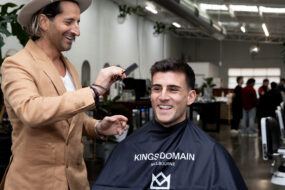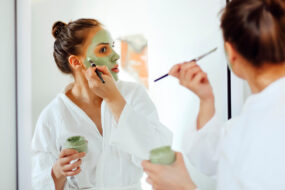5 fake tan mistakes to stop making
There’s nothing worse than orange undertones or patchy finishes. Here are five fake tan mistakes to stop making for a natural-looking glow.
Summer may be a distant memory, but that doesn’t mean you have to say goodbye to bronzed, radiant skin.
Why not continue your fake tan regimen for a look that captures sunny days and that just-back-from-a-vacay glow?
In winter, you might want to consider dialling down the shade a little for a more natural-looking tan that’s more suited to the season.
Here are five fake tan mistakes to stop making for a flawless finish.
1. Going too dark
The key to a winter tan is keeping it within a natural-looking shade range, no deeper than one to three shades different to your natural tone.
Honey Wax and Tan founder Kristen Crowe says adopting a conservative approach will stop your tan veering into unnatural territory.
“Everyone wants a natural look unless they’re preparing for some type of bodybuilding or dance competition. Most people want to enhance their colour without going over the top,” Kristen says.
Not only is gradual self-tanner a popular choice for achieving a natural-looking winter glow, it’s also safe for fake tan rookies as it can gradually build a deeper tan if regularly applied. Alternatively, opt for a fake tan product labelled “light”.
2. Choosing the wrong undertone
When it comes to self-tan products, you may notice that some claim to have either a violet base or green base.
The different base colours correspond to the undertones of our skin, and choosing the right base colour can result in a much more realistic, flattering result.
The three main skin undertones to consider for self-tanning products are cool, warm and neutral.
Skin with pink or reddish undertones is typically considered to be cool toned, and a green-base fake tan product is your best choice.
Those with yellow or golden undertones are considered warm, and so a violet base is the best option.
Skin that has both pink and yellow undertones is considered neutral. If you think your skin fits this profile then you can choose either a green or violet base and decide which one you think looks better.
You may also notice some products refer to brown, ash or caramel bases. These shades are often a combination of green and violet bases to try to be universally flattering.
Kristen says whether you choose a green or violet base, both are much more realistic than old-school fake tans, which were more orange-toned.
And don’t be alarmed at the colour when first applied.
“Whether it’s violet or a green base or neutral undertone, it may look violet or greenish when you’ve just applied it, but once that product has developed and you’ve showered, it looks natural,” Kristen says.

3. Using the wrong formula
Much like the undertone of your chosen product, the formulation can also impact how well the tan develops and wears.
“A cream or a mousse texture spreads very easily and avoids streaks, so that’s ideal for someone self-tanning for the first time,” Kristen says.
“A spray can sometimes miss places and risk unevenness so you would still need to use a tanning mitt to spread the product evenly on the skin.”
Melbourne-based Emily Roberts, a professional spray tan artist for 10 years, recommends foam formulas for those new to fake tanning.
“Foam is more foolproof for beginners since you can see the application and see what areas you’ve covered,” Emily says.
4. Not prepping your skin
Flaky, dead skin can mark the difference between a flawless, natural-looking tan and a patchy disaster, which is why exfoliating your body before fake tan application is so important.
It’s particularly relevant for winter tans as our skin is more susceptible to dryness in the cooler seasons, leading to a build-up of dead skin.
According to Kristen, much of the exfoliation process can be done in the shower.
“Before applying your tan, first shower and exfoliate with a loofah mitt or an exfoliating product to reduce dry skin around elbows and knees especially,” she says.
“Don’t apply body lotion or products like deodorant on the skin, so that the skin is a fresh canvas. And be sure to remove any existing self-tanner before applying a fresh coat.”
5. Skipping moisturiser
Dry areas of the body, such as the knees and elbows, can absorb more tanning product, which results in patchiness.
“You can apply some moisturiser to dry areas like heels or elbows to avoid product catching and building up in those places,” Kristen says.
“If you can get someone to help you to apply the tan to your back, that avoids missing those awkward-to-reach spots.”
If application results in streaks, Emily recommends using a tan-erasing product to remove the colour and start over.
“Leave the product to dry for a couple of minutes. Don’t wear anything too tight, so perhaps an oversized, loose T-shirt or dress. A slide or a thong would be ideal to avoid shifting the product on your feet,” Emily says.
“If you’ve shaved, wait a day to apply self-tan to avoid irritation.
Winter dryness can also shorten the lifespan of your tan, leading to the product fading more quickly.
To avoid this, Kristen stresses the importance of moisture to maintain an even tan as long as possible.
“Moisturise as much as possible and avoid really hot showers. It will get a bit patchy after a week, so it’s best to exfoliate at that time to remove unevenness,” she says.
More winter skincare tips:
- 5 winter-proof beauty hacks to add to your skincare routine
- How pretty in peach became winter’s hottest aesthetic
- Skincare for men in their 20s, 30s, 40s and beyond
- The beauty habit that could be ageing your skin
- Why Jacqui Felgate is in favour of using fake tan
Written by Cat Woods



